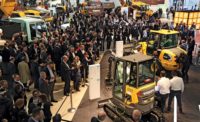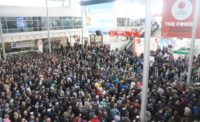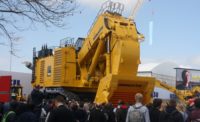Mining Will Be Major Focus of Bauma 2016 Equipment Show

Crowds line up to get into the Bauma trade show in 2013. Organizers expect over half-a-million people to descend on Munich for the next show in April, 2016.
Photo courtesy Messe München

Stefan Rummel, managing director of Bauma trade show organizer Messe München, says the 2016 show will have a special focus on mining equipment.
Photo courtesy Messe München


As the world's largest construction equipment trade exposition, Bauma draws in half a million people to Munich every three years to see the latest developments in heavy iron. But attendees to the show on April 11-17 next year will also see a renewed focus on mining equipment, according to show organizers.
"In 2016 we have a focus on mining, because we think that mining is getting more and more important for the construction machinery industry, as a whole, and we have a lot of exhibitors that also have mining products," says Stefan Rummel, managing director of Messe München, which runs the Bauma show. "The companies are already there, but we tried to make the mining segment more visible."
Getting any single manufacturer or market segment more visibility at Bauma is no small feat. The show will cover over 6.5 million square feet of the Messe München exhibition center, with almost 3,400 exhibitors from over 50 countries. "We'll have a guide to all the exhibitors with mining," says Rummel. "There will be over 700 exhibitors with mining equipment to show, so it will be easy to find them."
Rummel acknowledges that the focus on mining equipment comes at a difficult time for the industry. "We know the mining sector in terms of general economics situation, is facing some challenges," he says.
Overall, the heavy equipment market has shifted somewhat from where it was at the last Bauma in 2013. According to Messe München's own analysis, construction-equipment sales have recovered and are showing signs of positive growth in the North American, European and Middle Eastern regions. "What we learned in the first half of 2015 based on the construction machinery sales, is that, especially the traditional continents, Europe and the US, are doing quite well," says Rummel. "In Europe it's Scandinavia and Germany driving it. Also the southern [European] countries are recovering from their crisis, and so we can see Europe is slowly having a growth in construction sales in the first half of 2015."
Economic problems in Russia and a fear of overcapacity in China are concerns for Bauma organizers, but Rummel thinks there is still room for these regions at the show next year. "I talked a lot with the owner of [the Russian construction-equipment trade show] CTT, and he says the company is still coming for the next edition of Bauma, because they want to show that there is a lot of need for infrastructure projects in Russia, and their market will one day pick up."
While some of the developing markets have slowed, renewed demand in the North American and European markets are driving many exhibitors' offerings. "We're going to be exhibiting equipment designed around the European market," says Zach Schultz, international sales manager for American Auger and Trencor, West Salem, Ohio. "As we look at our future trajectory as a company, Bauma means a lot because it's such an international show and a chance to meet international customers."
According to Messe München, the largest display at the show will belong to Liebherr, with 145,000 sq ft of space. The largest U.S.-based exhibitor will be Terex. "It is hard to capture how large our stand is at Bauma," says Michelle Murphy, marketing manager for Terex. "If everything goes through with our merger, we could be Konecranes-Terex by the time of the show. But we still see Bauma as important. We'll have over 50 products on display at the show, and will be launching new products as well."
With a shifting global equipment market, Rummel sees a broader role for his company's trade show going forward. "Bauma is going to be a neutral platform for the industry. Not only for the greater internationalization of our brand to new shows around the world, but to develop more and more services for the industry."







